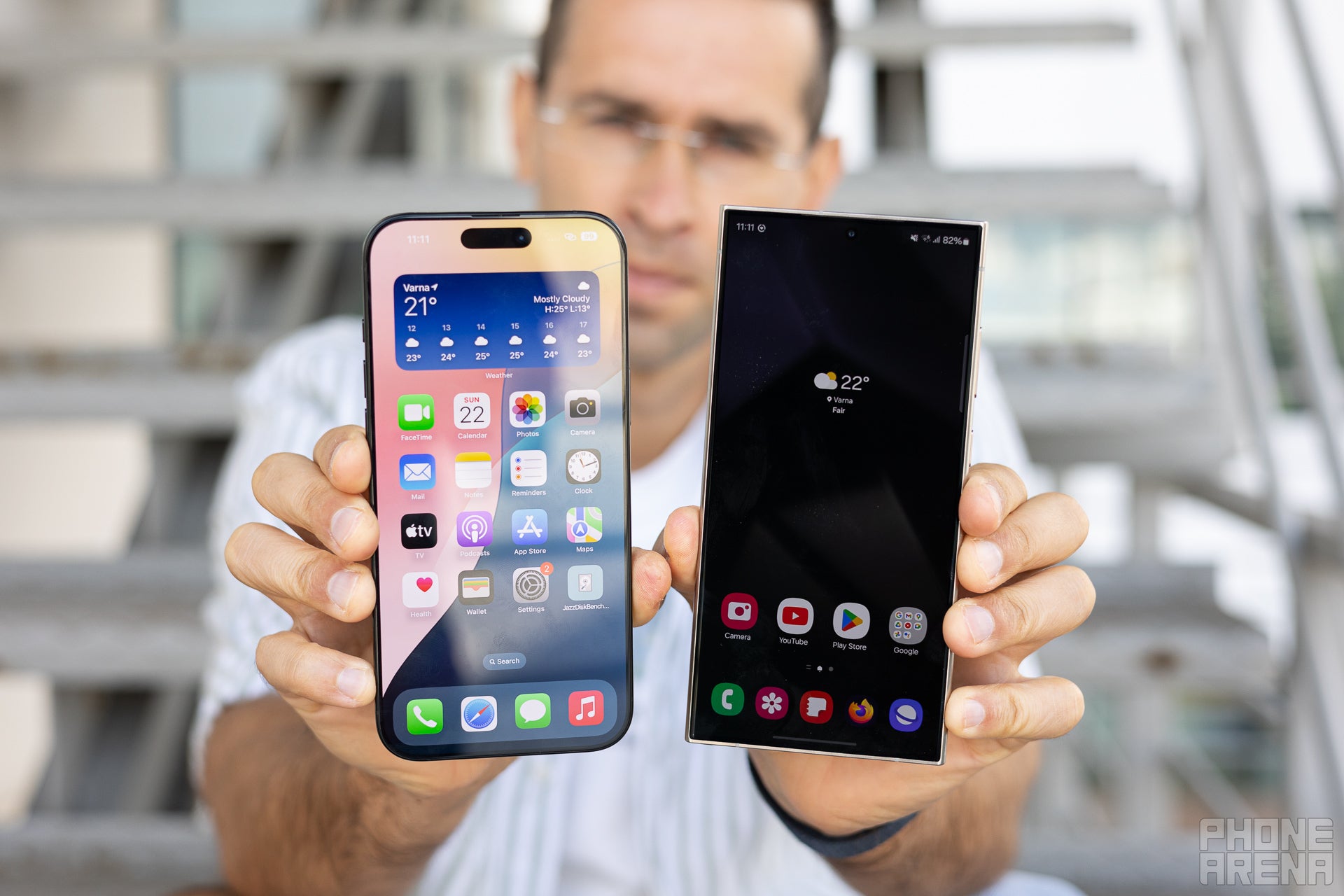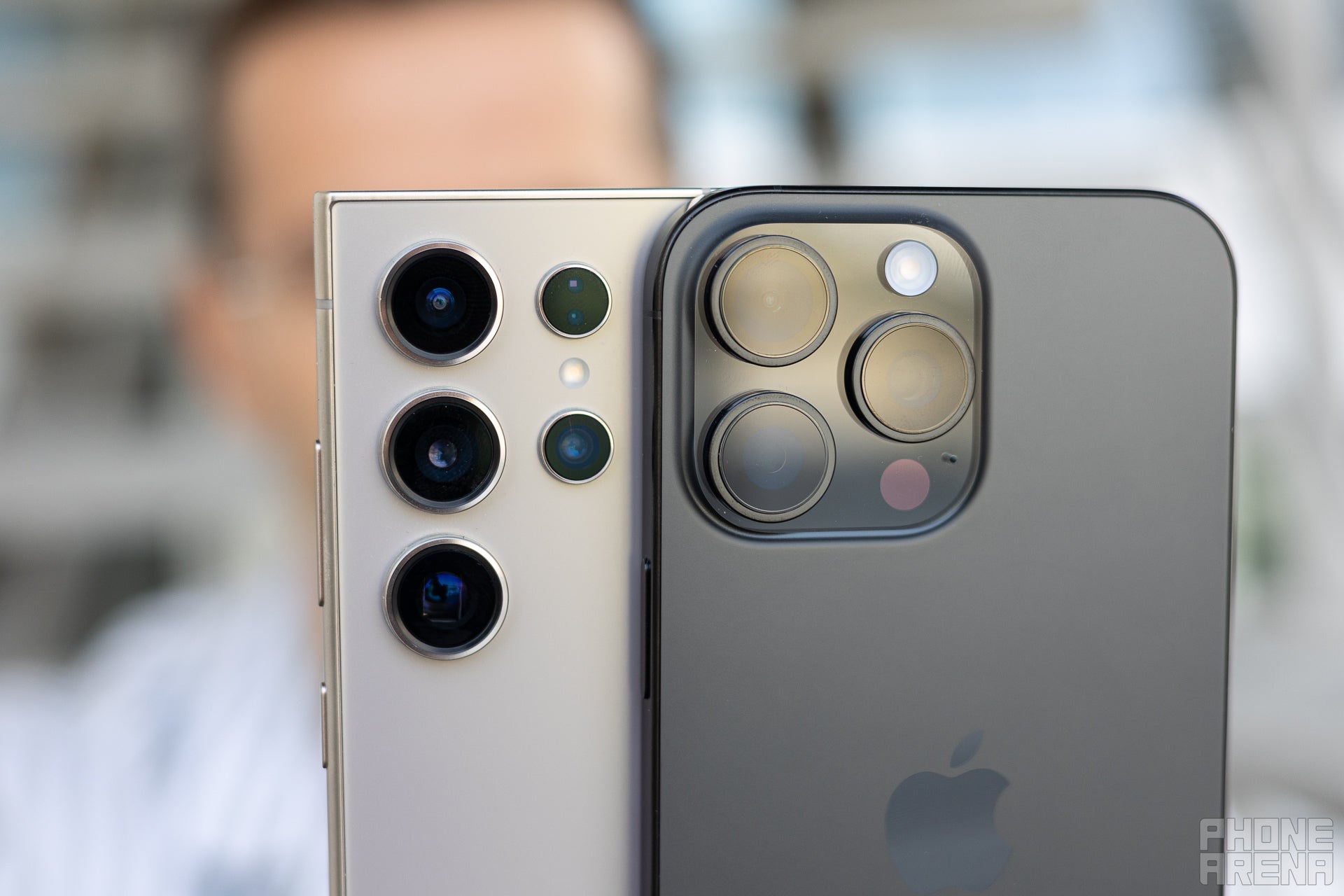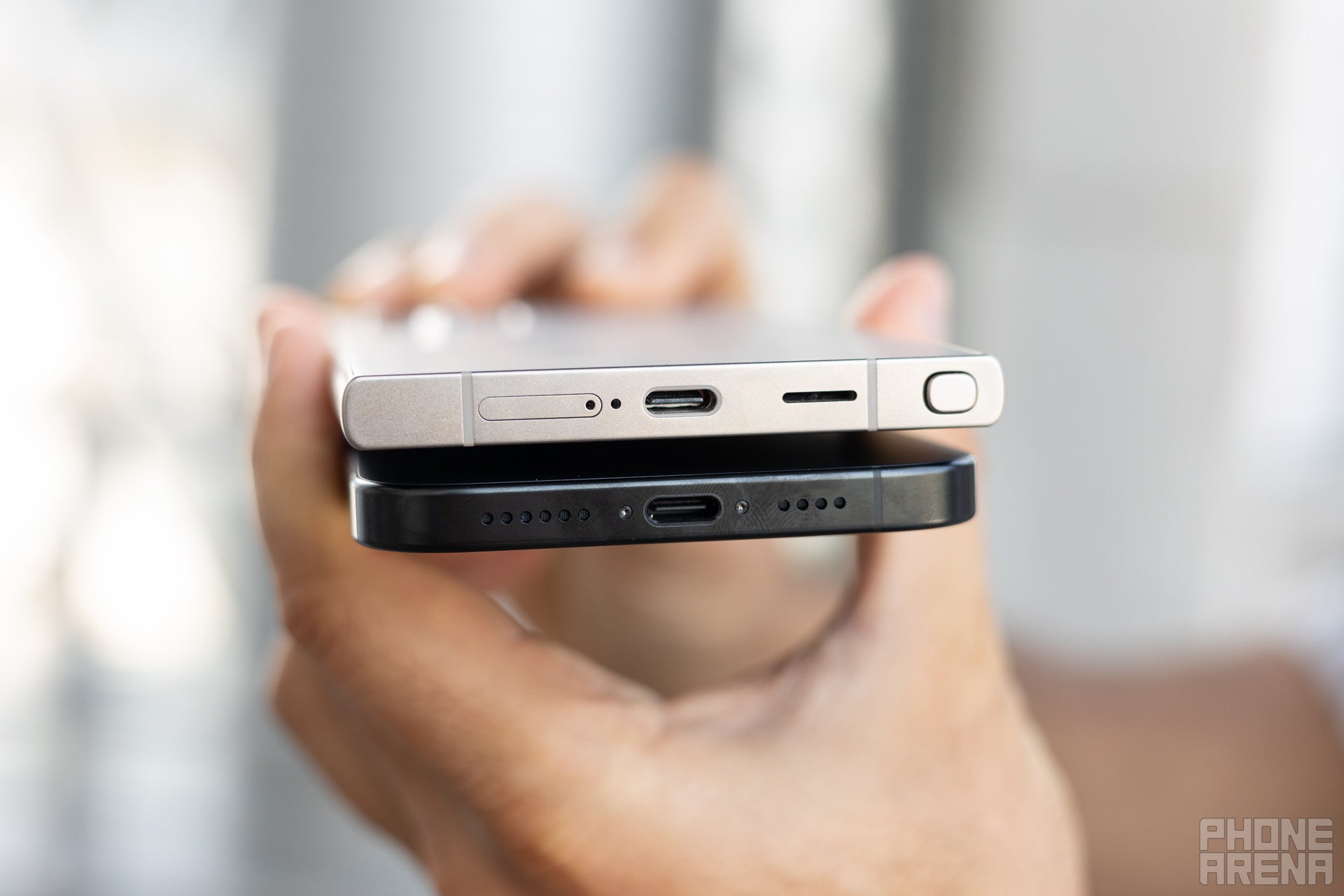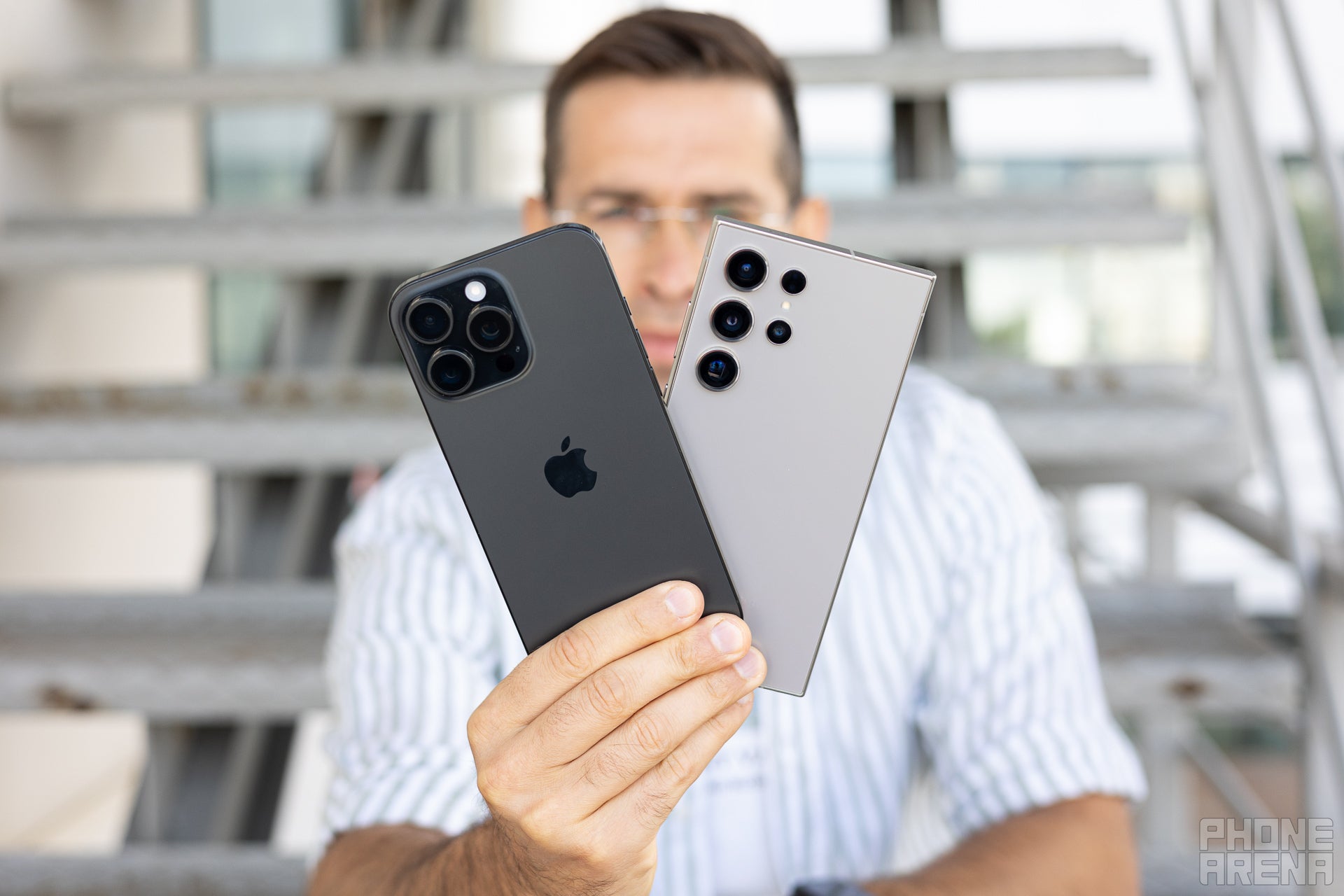iPhone 16 Pro Max vs Galaxy S24 Ultra: Battle of the Bigs
We may earn a commission if you make a purchase from the links on this page.

Intro
The iPhone 16 Pro Max doesn’t need much of an introduction. Year after year, it’s the largest, most powerful, and most coveted model in Apple’s lineup, and the latest iteration is no different.
But there are some changes. The iPhone 16 Pro Max now comes with a larger 6.9-inch display (up from 6.7 inches) and is powered by a cutting-edge processor built on a 3 nm process. Plus, it’s diving headfirst into the world of AI — more on that shortly.
Its release has shaken up a market that had been dominated by the Galaxy S24 Ultra for months. Samsung’s flagship has made a huge impact, boasting Galaxy AI with features like text composition, summarization, image generation, live translation, and more. With its custom-tuned Qualcomm Snapdragon 8 Gen 3 for Galaxy, a gorgeous 6.8-inch AMOLED display, versatile software with S Pen support, and fantastic cameras — plus a few AI features of its own — it’s firmly established as one of the most powerful Android smartphones.
Let’s dive into the details and see how the new iPhone 16 Pro Max stacks up against the slightly older Galaxy S24 Ultra.
But there are some changes. The iPhone 16 Pro Max now comes with a larger 6.9-inch display (up from 6.7 inches) and is powered by a cutting-edge processor built on a 3 nm process. Plus, it’s diving headfirst into the world of AI — more on that shortly.
While the Galaxy S24 Ultra is now handing the baton to the Galaxy S25 Ultra, it’s not going anywhere anytime soon. It’s still available for purchase, and many users aren’t rushing to upgrade since the S25 Ultra is a relatively minor update. The Galaxy S24 Ultra remains one of the best Galaxy phones you can buy today.
Let’s dive into the details and see how the new iPhone 16 Pro Max stacks up against the slightly older Galaxy S24 Ultra.
iPhone 16 Pro Max vs Galaxy S24 Ultra differences:
| iPhone 16 Pro Max | Galaxy S24 Ultra |
|---|---|
| Second-gen 3nm Apple A18 Pro chip | Qualcomm Snapdragon 8 Gen 3 "For Galaxy" tuning |
| 48 MP main camera | 200 MP main camera |
| New, 6.9-inch display, OLED, 120 Hz | 6.8-inch, AMOLED screen, 120 Hz |
| New Camera Control Action Button | No special buttons |
| No stylus inside | Rocks an integrated S Pen |
| Apple's AI incoming | Samsung AI with summary, transcripts, live translate, generative edit |
| 4,685 mAh battery | 5,000 mAh battery |
| 20 W wired charging | 45 W wired charging |
| 25 W MagSafe | Slower 15 W wireless charging |
Table of Contents:
Read more:
- Apple iPhone 16 Pro Max: New features, price, specs, and release date
- Samsung Galaxy S24 Ultra review: zoom in, enhance!
- The best iPhone to buy: our verdict
- Samsung Galaxy S24 Ultra vs Galaxy S24 FE: The decadent flagship or the sensible purchase?
- iPhone 16 Pro Max vs iPhone 14 Pro Max: Is it time to upgrade?
Design and Size
Important changes

As usual, the iPhone does not change much about its looks — we have the same rectangular shape with soft corners, flat sides with a bevel, and yes — a Dynamic Island pill-shaped cutout in the display, exactly where the selfie camera and Face ID sensors sit. There is also an even thinner bezel and the screen grows to 6.9 inches in diagonal, ever so slightly larger than the Galaxy S24 Ultra's 6.8-inch panel.
But it's not just bezel magic — the dimensions of the iPhone 16 Pro Max also change slightly, to 163mm x 77.6mm, whereas the Galaxy S24 Ultra is 162.3 x 79. So yes, the Galaxy is wider, which helps with S Pen writing.
But it's not just bezel magic — the dimensions of the iPhone 16 Pro Max also change slightly, to 163mm x 77.6mm, whereas the Galaxy S24 Ultra is 162.3 x 79. So yes, the Galaxy is wider, which helps with S Pen writing.
Apple is now all in on physical buttons too. First, the Action Button makes a return. Introduced with the iPhone 15 Pro models, it replaces the Mute toggle and can be programmed to various functions. It can open you favorite app, turn on a specific Focus mode, or even launch any Siri shortcut.
But you have one brand new button too — the Camera Control. It is a physical key with a capacitive surface. As the name suggests, it works with Apple's camera app, but believe it or not, it is also open for use by 3rd party camera apps. In many ways, this is like the shutter key on a traditional camera, but Apple adds a special touch with that capacitive surface, so you can swipe on it to zoom in and out, or control other camera features. Very cool.
As for colors, Apple sticks with its more restrained hues for the Pro models. You have the following colors this year:
- White Titanium
- Black Titanium
- Natural Titanium (gray)
- Desert Titanium
Samsung offers a slightly larger collection. On regular, you can get the Galaxy S24 Ultra in:
- Titanium Violet
- Titanium Yellow
- Titanium Black
- Titanium Gray
However, if you order from Samsung.com, there are three extra exclusive colors to pick from — Titanium Blue, Titanium Green, Titanium Orange.
Samsung might not use extra hardware buttons beyond the power and volume ones, but it has an S Pen nested into the bottom of the phone. Some people love that, others rarely use it, but it remains a unique feature among high-end smartphones. Samsung's stylus is nothing to snark at — it's the result of years of development and a partnership with Wacom, so it's incredibly accurate and expreissive, be it for writing or sketching.
Both devices have a USB-C ports on the bottom, supporting USB 3 speeds.
Also read: iPhone 16 colors
How you unlock these two is a very different experience. The Galayx S24 Ultra uses an ultrasonic fingerprint scanner under the screen — it's excellent, but still requires you interact with the screen of the device. Apple's iPhones have been using Face ID for years now, and it is not changing in the 16 Pro Max.
Display Differences

So, the iPhone 16 Pro Max comes with the largest screen ever on an iPhone at 6.9 inches. As with the 15 Pro series — you have that Always-On feature, which drops the refresh rate to 1 Hz and keeps your wallpaper or custom picture still over the entirety of the screen.
The Galaxy S24 Ultra uses Samsung's homemade AMOLED panel, also with a variable refresh rate that can drop down to 1Hz. It also has Always On, though a bit more conservative as the Galaxy cannot do the "all screen wallpaper" while the phone is asleep.
The Galaxy S24 Ultra uses Samsung's homemade AMOLED panel, also with a variable refresh rate that can drop down to 1Hz. It also has Always On, though a bit more conservative as the Galaxy cannot do the "all screen wallpaper" while the phone is asleep.
The big difference between these two, however, is reflectivity. The Galaxy comes with a special anti-reflective coating that obliterates most reflections and this helps immensely to see the screen easily outdoors. The iPhone does not have that feature, which is sorely missed. However, make no mistake — the iPhone does have enough brightness to blast, so it's visible under the bright sun:
As for colors, both of these look fantastic. Of course, they are not perfect — it's pretty hard to get that pentile matrix to be exact. Compared side by side, the iPhone's display pulls slightly towards yellowish hues, the Galaxy S24 Ultra is a little teal-ish. But when you throw blue light filters and adaptive color calibration — both phones have this — into the mix, this point becomes moot. At the end of the day, they are sharp, accurate, and great to look at.
New this year for the iPhone is it can drop to 1 nit minimum brightness, so it's easier on the eyes at night. In our measurements, it's even slightly lover than 1 nit — certainly a welcome improvement. Samsung's screens also hover around this, so they were already pretty comfortably for nighttime use.
The iPhone's front is protected by a new generation of Ceramic Shield front glass — it's proven itself to be quite shatter-resistant. Samsung's flagship has an exclusive Corning Gorilla Armor, which is an excellent glass with an exceptional anti-glare coating — not only does it protect the screen quite well, it also improves the viewing experience immensely. We can also testify that, after months of daily use, the Gorilla Armor on our Galaxy S24 Ultra doesn't have any annoying micro scratches, which typically appear on phones out of nowhere.
Performance and Software
Delving deeper into 3 nm... for some

Under the hood of the iPhone 16 Pro Max, you get an Apple A18 Pro chipset. Built on the second-gen 3nm process by TSMC, it is cutting edge and at the time of the launch, it's the first phone to use that process (but not the first 3 nm phone chip, that was the A17 Pro).
The previous A17 Pro chip that Apple used was powerful, but it needed to throttle just after a couple of minutes of hard work. And the iPhone 16 Pro and Pro Max seem to address that with a new heat dissipation solution and better efficiency.
The Qualcomm Snapdragon 8 Gen 3 inside the Galaxy S24 Ultra is also a stellar performer, capable of standing toe-to-toe versus Apple's silicon. Especially considering that it takes a bit more stressing to make it throttle.
And here are the benchmarks. In CPU score, the Apple A18 Pro is back on top and by considerable margin at that! However, with 3D graphics, it's not that much of a clear winner. The Galaxy S24 Ultra got a higher peak score, but throttled down lower. But, in general, they are in the same ballpark. Of course, the next generation of Qualcomm chips — and the next Galaxies — are just a few months away, so we'll see what they do to one-up Apple.
But another point about 3D gaming — Apple has been doing a steady push into gaming. For one, it's the improvements and upgrades with 3D performance and hardware ray tracing, but also partnerships with game developers that bring console titles to the iPhone and iPad — Resident Evil, Assassin's Creed, Death Stranding, and who knows what is coming. Samsung, and other Android manufacturers like Asus, do need to try and get some of that pull, as they have spent years to get a piece of that handheld gaming market, and it seems Apple is now getting a steady footing in it instead.
The race these days is for AI features and performance, of course. And Apple's new silicon has the dedicated NPU cores to support "Apple Intelligence" features, which will be trickling into iOS periodically, starting from October. But the Galaxy S24 Ultra already has Galaxy AI — with note / website / recording summaries, live translation, generative image editing, chat assist, which can make coherent messages out of a few words, Google's Circle to Search, and some more tricks.
Apple's AI, is rolling out in a staggered manner. We already got iOS 18.1 and iOS 18.2. The first one gave us all the text-based features. Summarized notifications and emails, text reprhasing, smart search in Photos, and Clean Up for Photos (like Magic Eraser — a generative image remover that makes up a background after). With iOS 18.2 in December, we got a deep ChatGPT integration where you can prompt ChatGPT via Siri or through your Notes or iMessage interface. And then more in March, with iOS 18.3, which should make Siri even smarter, but we've heard that numerous times before.
These have a lot of similar AI features, under different names. For exclusives, Apple has notification summaries and ChatGPT integration. Samsung has Sketch to Image and Live Translate during phone calls.
Samsung's One UI 7 is not far behind and, unlike Apple, Samsung doesn't stagger its AI features. We expect new tooll to become available once the Galaxy S25 series launches in January. Word is, Bixby is about to become a whole lot smarter, with the power of Samsung's own Gauss LLM supposedly reinforced with Google's Gemini. Hang back for the new AI features to become available so we can compare them again! They will surely come to the Galaxy S24 Ultra, as Samsung has committed to a long-term update schedule.
The iPhone 16 Pro Max also upgrades to Wi-Fi 7, supposedly to facilitate 4X data speeds over the previously-used Wi-Fi 6E. The Galaxy S24 Ultra already does support Wi-Fi 7.
When it comes to software, we have two well-matured operating systems here — Apple's iOS versus Samsung's One UI. This year, you could say that iOS is closer to Android than ever. You can now put app icons wherever you want on the homescreen, not just in a row (yes, in 2024, imagine that). And you can customize it further by selecting a specific color for all your app icons to be painted in.
But if customization and flexibility is what you are after — it still can't beat One UI, which has split screen, an app drawer on the side, boundless homescreen customization, themes, and much more.
For software updates, Samsung has also upped its game. The new Galaxy flagships come with a 7-year software update commitment, meaning the Galaxy S24 Ultra will hit its cap in 2031. Apple iPhones typically get 5 years worth of iOS updates. In reality — 5 years is plenty enough, as at that time the phone's hardware may also be beat up enough to warrant an upgrade. But 7 years is just unbeatable headroom.
Also read: iPhone 16 AI features
Camera
Ultra Max Super, all of the megapixels

After upgrading the main camera with the iPhone 13 Pro Max, then the zoom camera with the iPhone 15 Pro Max, Apple now turned its sights to the ultra-wide camera — the iPhone 16 Pro Max now comes with a 48 MP ultra-wide, instead of 12 MP. The main sensor is also 48 MP, and the 5x telephoto camera has a 12 MP sensor underneath.
Additionally, Apple has a new lens coating to deal with the lens flare that has become kind of a meme over the past 4 years — especially night shots were often dotted with small flares of light, captured and bouncing between the phone's multi-layer lenses.
The Galaxy S24 Ultra has a 200 MP main camera, 10 MP 3x telephoto camera, another zoom camera that's 50 MP and 5x, and a 12 MP ultra-wide camera.
It's not all about the megapixels and lenses, though, as in the world of smartphones, automatic post-processing plays a huge part in the final image. So, we have to field test them!
PhoneArena Camera Score:
The iPhone 16 Pro Max camera, while great, did not bring about any major improvements or groundbreaking new features. Most of what's new is on the software end, with Photographic Styles and the new 4K 120 FPS mode for super-detailed slow-mo clips. However, it still scores about the same on our Camera Benchmark test as the iPhone 15 Pro Max — and a point or two below the Galaxy S24 Ultra, depending on which category you are looking at.
But the good news is that a point or two means nothing, and it's still an excellent camera. Let's check out some samples:
Main Camera
Both phones handle dynamics and colors great, and the resulting images are excellent on both sides. There are differences that we can latch onto, however — surprisingly, the iPhone tends to oversharpen fine details a bit more. You can spot jagged edges around leaves that simply don't look natural. That's a weird reversal, as just a few years ago it was Samsung that tended to oversharpen.
On the Samsung side, we still have the issue with greens being a bit too saturated or skewed a bit away from reality. Though, it's not that much of a problem on the S24 series — it only becomes evident when you compare it directly to more "honest" colors, like the ones from the iPhone here.
When the light goes down, both phones start working overtime with their noise reduction and sharpening. The results are mixed. We find that if there are more artificial light sources around, Samsung photos tend to be a bit better, with more striking colors and contrast. But as the light becomes less and less, it's the iPhone that manages to reproduce better detail and colors. You can see more samples below in the "extra" gallery to see what we are talking about. But, in general, great night photos from both cameras. And, both produce an equal amount of disappointing artifacts when overdoing the noise reduction.
On the Samsung side, we still have the issue with greens being a bit too saturated or skewed a bit away from reality. Though, it's not that much of a problem on the S24 series — it only becomes evident when you compare it directly to more "honest" colors, like the ones from the iPhone here.
When the light goes down, both phones start working overtime with their noise reduction and sharpening. The results are mixed. We find that if there are more artificial light sources around, Samsung photos tend to be a bit better, with more striking colors and contrast. But as the light becomes less and less, it's the iPhone that manages to reproduce better detail and colors. You can see more samples below in the "extra" gallery to see what we are talking about. But, in general, great night photos from both cameras. And, both produce an equal amount of disappointing artifacts when overdoing the noise reduction.
Zoom Quality
A bit of an Uno Reverse card here — the Galaxy S24 Ultra oversharpens a bit more as you zoom in, while the iPhone 16 Pro Max confidently lets some details come out soft. But in the end, at a reasonable zoom of 10x, the iPhone photo looks a bit more realistic with both colors and details being more grounded. The S24 Ultra photos just appear a bit too processed.
Now, both of these phones have 5x telephoto lenses and do digital processing beyond that. It's worth noting that the iPhone still taps out at 25x zoom, while the Galaxy goes all the way up to 100x.
Now, both of these phones have 5x telephoto lenses and do digital processing beyond that. It's worth noting that the iPhone still taps out at 25x zoom, while the Galaxy goes all the way up to 100x.
Ultra-wide Camera
Both ultra-wide cameras try to stick with the same color calibration as their respective main cameras. So, here, we have the same slight discrepanices in color science. The Galaxy is a pinch more saturated, maybe slightly warmer. The iPhone is a bit more grounded. Both ultra-wide cameras handle high dynamics very, very well and display visible oversharpening that seems to be happening in the post-processing. All in the name of a clear ultra-wide landscape shot, we presume.
Selfies
Both of these phones take pretty good selfies with a wide dynamic range and lots of detail. But, consistently, the iPhone captures better skintone and more vibrancy in the background. The S24 Ultra selfies appear just a bit washed out, with some yellow-greenish hues in the skintones. You can check more selfie samples in the gallery below:
More Camera Samples
Also read: iPhone 16 camera: All the upgrades
And we should once again mention the useful new Camera Control on the iPhone which makes taking photos and videos just a bit easier.
Of course, iPhones do have a slight advantage with the Photographic Styles — you can fine-tune how your iPhone camera processes photos. With the new iPhone 16 Pro series, there are more options and you can even go deeper with individual color saturations.
For video quality, the big ticket item on the 16 Pro Max is 4K120 slow motion. This is high quality, detailed footage that we have so far only seen on one phone, the camera-centric Sony Xperia 1 lineup. And it's a feature that pros will love. The Galaxy does not support that.
Another great addition is four studio quality mics on the 16 Pro Max, which should help you get crisper vocals and overall audio in your footage. And a new Audio Mix edit will let you choose between a few ways of mastering your clip, which is wild.

Looking at them side by side, video from both phones looks comparable in terms of wide dynamics and good stabilization. The iPhone's signature warm yellow-ish leaning is visible, and the Galaxy S24 Ultra flirts with magenta a bit more. Notably, the S24 Ultra footage looks much charper when we zoom in with both phones. Otherwise, you won't be disappointed by the video from either of these.
Battery Life and Charging
The iPhone raises the bar once again

The iPhone 16 Pro Max gets the longest battery life ever on an iPhone, and that is impressive considering previous phones were also long-lasting. What does that mean, though? Thanks to teardowns, we know the 16 Pro Max battery is 4,685 mAh — really the biggest battery in an iPhone (the 15 Pro Max had 4,422 mAh). That's up against the Galaxy, which has a 5,000 mAh cell, which is considered the current golden standard for big-sized flagship phones.
Of course, we have iOS and Android thrown in the mix, as there's a huge difference between how these operating systems deal with app processes and how their battery percentages trickle out. iOS is great with standby, which is why iPhones typically do great even with smaller batteries. Android is a bit more liberal with letting apps do stuff in the background — but the bigger batteries typically offset that.
But OK, what about full-on use? Well, our battery test is designed to simulate just that:
PhoneArena Battery and Charging Test Results:
Well, when it comes to the simpler task — like browsing, reloading, scrolling webpages, the iPhone goes on for 2 hours more than the Galaxy. That's a 10% improvement there, but we still do wish to point out that 20 hours of screen-on time already sounds incredibly healthy as far as battery endurance goes. For YouTube streaming, the iPhone goes on for 2 extra hours yet again — this time, it's a 25% improvement over the Galaxy S24 Ultra's endurance. We do wish to point out that Samsung Galaxies are notorious for always getting low battery scores on the YouTube tests, even when compared to other similar Android phones.
Then, with gaming, the Galaxy gets a bit of a victory, with almost 2 hours on top of the iPhone or about 15% more.
When it comes to charging, Apple sticks with depressingly slow 20W wired charging speeds yet again on the 16 Pro Max. The Galaxy charges faster with 45W support.
But interestingly, MagSafe wireless charging is now much faster on the 16 Pro Max with speeds of 25W. Yes, you read that right – wireless charging is faster than wired charging on this iPhone. We've never seen such a thing on any phone so far.
This should give you 50% charge in just 30 minutes, while the Galaxy which supports 15W wireless charging only gets around 33% in the same time period (and it has a bigger battery).
Just remember that you'd need the new MagSafe 25W charger and you have to connect it to a power brick that can deliver at least 30W of power.
Also read: iPhone 16 Battery and charging
Audio quality and Haptics

iPhones sound great — especially the ones that have more room for the sound to bounce in. Those being the Plus and Pro Max models. The new iPhone 16 Pro Max continues the tradition of loud and clear sound, with plenty of brilliance in the highs and surprisingly audible bass.
But the Galaxy S24 Ultra also sounds pretty good. It's a bit of a different profile — the Galaxy has more mids, while the iPhone is a bit more scooped. But it also produces a lot of bass... somehow! In either case, we wouldn't mind the sound out of either of those phones.
As for haptics — the iPhone Taptic engine has been incredible since inception. Precise and pleasing clicks with every interface interaction. But Android has now almost caught up, and Samsung's vibration is almost as good.
Specs Comparison
Here's a quick look at the essentials here. But you can open up the full iPhone 16 Pro Max versus Galaxy S24 Ultra specs comparison, if you wish to delve deeper.
| iPhone 16 Pro Max | Galaxy S24 Ultra |
|---|---|
| Size 163 x 77.5 x 8.25 mm | Size 162.3 x 79 x 8.6 mm |
| Weight 227 g | Weight 233 g |
| Display 6.9" OLED 120Hz ProMotion | Display 6.8" AMOLED 120Hz |
| Processor A18 Pro 3 nm | Processor Qualcomm Snapdragon 8 Gen 3 4 nm |
| SKUs 8 GB/256 GB 8 GB/512 GB 8 GB/1 TB | SKUs 12 GB/256 GB 12 GB/512 GB 12 GB/1 TB |
| Cameras 48 MP main 48 MP ultra 12 MP 5X telephoto - 12 MP front | Cameras 200 MP main 12 MP ultra 50 MP 5X zoom 10 MP 3X zoom 12MP front |
| Battery 4,685 mAh | Battery 5,000 mAh |
| Charging USB-C 20 W wired 25 W MagSafe | Charging USB-C 45 W wired 15 W MagSafe |
Summary

The iPhone 16 Pro Max may not be the earth-shattering, game-changing upgrade many expected, but it certainly brings its own set of notable improvements. With iOS 18 adding a fresh layer of excitement, this remains a top-tier premium smartphone that will set the standard for comparisons in the coming year.
The standout features include the larger screen size, slimmer bezels, the faster chip with improved cooling, a new ultrawide camera, 4K120 video recording, and the new Camera Control. However, the most significant upgrade might be the longer battery life, which is sure to be a game-changer for everyday users.
But let’s not overlook the Galaxy S24 Ultra — this powerhouse has been a top contender since its January release. It offers solid performance, a wider screen with S Pen support, a more versatile zoom camera, and arguably more advanced AI features compared to the iPhone. Plus, it comes with unique features like DeX that you won’t find on the iPhone (or most other Android devices).
And let’s not forget, the Galaxy S25 Ultra is on the horizon, likely coming in early 2025 (possibly January). If it builds on the strong foundation of the S24 Ultra, it could be worth the wait.
If you’re looking to buy a flagship smartphone right now and are deciding between the Galaxy S24 Ultra and the iPhone 16 Pro Max, both are exceptional choices. The decision really comes down to the broader ecosystem that suits you best — iOS or Android? Apple Watch or Galaxy Watch? Are you using an Apple computer or a Windows/Samsung laptop? Or maybe you’re platform-agnostic? In that case, pick the one that looks better to you!
The standout features include the larger screen size, slimmer bezels, the faster chip with improved cooling, a new ultrawide camera, 4K120 video recording, and the new Camera Control. However, the most significant upgrade might be the longer battery life, which is sure to be a game-changer for everyday users.
But let’s not overlook the Galaxy S24 Ultra — this powerhouse has been a top contender since its January release. It offers solid performance, a wider screen with S Pen support, a more versatile zoom camera, and arguably more advanced AI features compared to the iPhone. Plus, it comes with unique features like DeX that you won’t find on the iPhone (or most other Android devices).
And let’s not forget, the Galaxy S25 Ultra is on the horizon, likely coming in early 2025 (possibly January). If it builds on the strong foundation of the S24 Ultra, it could be worth the wait.
































Things that are NOT allowed: